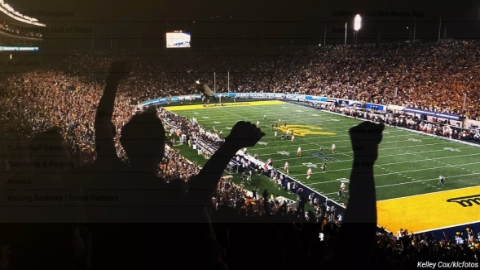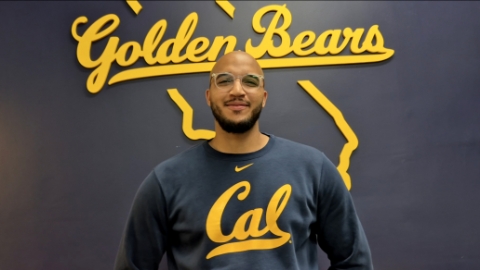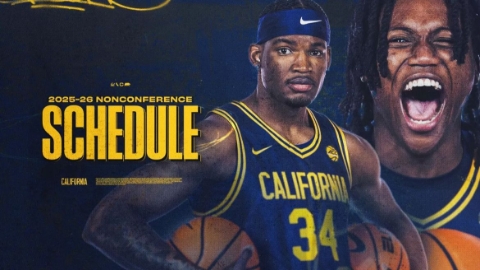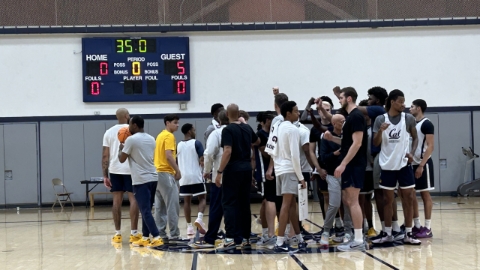
With last week’s pledge from Makale Foreman, a 6-1 guard graduate transfer from Stony Brook, Cal basketball’s 2020-2021 roster is set barring any unexpected changes. Makale capped-off a five-man incoming class that includes two graduate transfers that will be immediately eligible, a traditional sit-one transfer, and two freshmen.
Before taking a look at expectations for each of the five incoming players, feel free to refresh yourself on the state of the current roster with our roster reset here.
Ryan Betley, 6-5/200, Wing, Grad Transfer (Penn)
Betley will be one of the oldest members on next year’s team and has already gone through four years of college hoops — all at Penn. There’s a lot to like about Betley. His experience is one. His consistency and shooting is another. Betley has averaged in double-digits points per game in all three seasons in which he played in at least half the seasons. This past season he averaged 11.6 points, shooting 42.9% from the field including 36% from three.
| Year | Games Played | Minutes | Points | FG% | 3P% | FT% | Rebounds | Assists | Blocks | Steals | Fouls Committed | Turnovers |
|---|---|---|---|---|---|---|---|---|---|---|---|---|
| 2019-2020 | 22 | 30.5 | 11.6 | 42.90% | 36.00% | 78.10% | 5.8 | 1.3 | 0.3 | 1 | 1.6 | 1.2 |
| 2017-2018 | 33 | 33.5 | 14.3 | 42.30% | 39.10% | 77.00% | 5 | 1.2 | 0.4 | 0.8 | 2 | 1.5 |
| 2016-2017 | 18 | 28.1 | 11.9 | 47.50% | 40.20% | 90.60% | 4.6 | 0.9 | 0.5 | 1.1 | 1.9 | 1.3 |
Reasons for optimism:
Proven scorer. Betley is a proven scorer. All three seasons in which Betley played consistently, his offensive rating has been above 100 with decent possession and shot percentages. Only three Cal players averaged more than 100 for an offensive rating last season: Matt Bradley, Andre Kelly, and Kuany Kuany.
Three-point shooting. Betley is a career 38.1% (164-of-430) three-point shooter. His eFG% rate last season was 53.2%. Only Kelly and Lars Thiemann had higher eFG% rates for Cal last season. For a team that needed help scoring last season, Betley should have an immediate role.
Reasons for concern:
Athleticism and increased competition. It’s going to be a question for the vast majority of graduate transfers from a mid- or low-major conference to a power conference. And Betley is no different. Will Betley’s efficiency and productivity drop off a bit with the increased competition and talent? If so, how much? The counter-argument is Betley actually held his own fairly well against the five KenPom top-100 teams he played against last season. In those games, Betley averaged 14 points per game including going off for 20 against Arizona and 22 at Providence.
Defense. At 6-5 and 200 pounds, Betley has good size. Is he going to be able to defend Pac-12 wings? Time will tell. If he wants to see the court consistently with Mark Fox as coach, he’ll have to prove he can defend.
Durability. The reason Cal is even able to include Betley on its roster this year is because he missed an entire season due to injury. Betley has only made it through one season without missing at least a few games due to injury. And the Pac-12 can be a physical conference.
Makale Foreman, 6-1/200, Guard, Grad Transfer (Stony Brook and UT-Chattanooga)
Mark Fox needed to fill a combo guard role with Kareem South’s departure. And he did that almost exactly with Foreman. From size to efficiency and productivity, there’s a lot of similarities between Foreman and South. But the 6-1 guard that transferred to Cal via Stony Brook via UT-Chattanooga might be the single-most-important addition to this year’s roster as he’s likely the main backup for sophomore point guard Joel Brown.
| Year | Games Played | Minutes | Points | FG% | 3P% | FT% | Rebounds | Assists | Blocks | Steals | Fouls Committed | Turnovers |
|---|---|---|---|---|---|---|---|---|---|---|---|---|
| 2019-2020 | 33 | 35 | 15.6 | 36.50% | 36.00% | 84.90% | 2.8 | 2 | 0 | 0.7 | 1.3 | 2.1 |
| 2017-2018 | 33 | 35.2 | 10.2 | 39.90% | 38.20% | 84.80% | 2 | 1.8 | 0 | 0.8 | 1.6 | 1.5 |
| 2016-2017 | 28 | 11.4 | 3.1 | 34.10% | 32.50% | 50.00% | 0.4 | 0.3 | 0 | 0.2 | 0.8 | 0.4 |
Reasons for optimism:
Durability. Foreman played in all of his team’s games in his past two seasons and averaged at least 35 minutes per game in both seasons. The dude is durable. And since Cal is relatively thin at the lead guard position, that’s a good thing.
Three-point shooting. Again, this comes with a caveat of increased competition (see more below), but as a sophomore at Chattanooga Foreman shot 38.3% from long-range and he shot 36% last season as a redshirt sophomore. Cal needs more consistent outside shooters and the additions of Betley and Foreman could potentially add just that. Foreman was an incredibly high-volume three-point shooter, taking 278 attempts last season. That’s 106 more attempts than Bradley.
Lead guard potential. Foreman played primarily as the main ballhandler last season at Stony Brook so he’s comfortable there. But with offensive ratings of 103.5 and 106.4, respectively, the last two seasons, he’s also able to score, especially off the dribble.
Reasons for concern:
Athleticism/talent upgrade. It’s no secret South’s numbers largely dropped off once conference play hit. Foreman is a similar player who will be asked to step into a somewhat similar role. With Paris Austin and Joel Brown, South wasn’t asked to play the point position as much as Foreman likely will. Foreman could also benefit from having experienced wing threats around him (Grant Anticevich as a senior, Bradley as a junior, and Betley as a grand transfer senior). There was a lot of pressure on South to produce points that hopefully won’t be there for Foreman.
Passing. But Foreman hasn’t necessarily proven himself as a deft passer as he averaged just two assists per game last season. Foreman will likely need to be a bit more productive and efficient as a distributor.
Two-point scoring. Foreman shot just 37.6% (62-of-165) from two-point range last season. As mentioned above, Foreman took a lot more three-point shots last season and averaged almost the same percentage. During his sophomore year at Chattanooga, Foreman put up a two-point shot rate of about 44%. That’d be better.
Jarred Hyder, 6-3/185, Guard, Transfer (Fresno State)
To be clear, we don't expect Hyder to play this season. There was hope the NCAA would grant a one-time transfer waiver for student-athletes to play immediately if it was their first transfer. But that didn’t pass. Considering Hyder chose a school further away from his home in San Bernardino and there was no coaching change at Fresno St., it doesn’t seem likely Fox would pursue a waiver or Hyder would get it if Cal decided to try.
In terms of long-term impact on the program, Hyder might be the most important and intriguing piece of this year’s recruiting class. The 6-3 guard averaged 9.1 points and 3.1 assists per game as a true freshman and had many high-major suitors when he announced his transfer.
| Year | Games Played | Minutes | Points | FG% | 3P% | FT% | Rebounds | Assists | Blocks | Steals | Fouls Committed | Turnovers |
|---|---|---|---|---|---|---|---|---|---|---|---|---|
| 2019-2020 | 26 | 31.9 | 9.1 | 38.00% | 30.20% | 83.30% | 2.6 | 3.1 | 0.1 | 0.5 | 1.7 | 2.5 |
Reasons for optimism:
A solid roster piece. Yes, Fresno State doesn’t have the same strength of schedule as Cal but of the mid-major conferences, the MWC is one of the more transferable ones to a power conference. And Hyder had a solid debut season. Hyder put up an offensive rating of 93.6 which was right with Cal’s senior guards in Austin (92.1) and South (94.9). Brown’s offensive rating was 77.4 with much lower minutes, usage rates, and shooting rates.
Having Brown and Hyder playing together or backing each other up over the next few years should be solid. The development and performance of these two will likely play a big role in how long Fox stays in Berkeley.
Finding the bucket. Averaging 9.1 points per game as a freshman in college is solid. Hyder didn’t shoot great from long-range (30.2% from three), but he found other ways to get points like shooting 44.4% for two-point shots and 83.3% from the free-throw line. He also had a low foul count and solid assist rate.
Reasons for concern:
Three-point shooting. Shooting 30.2% on 96 attempts isn’t great. But hopefully, Hyder is never the primary long-range shooter on Cal’s roster while he’s in Berkeley.
Turnovers. Hyder did average 2.5 turnovers per game last season, which obviously isn’t great. For reference, no one on Cal’s roster averaged more than 2.3 turnovers per game last season. Both Bradley and Austin averaged 2.3.
There’s a lot to like and potentially a lot of upside for Hyder.
Jalen Celestine, 6-7/205, Wing, Long Island Lutheran
True freshman Jalen Celestine looks to be an intriguing, albeit developmental piece on Cal’s roster over the next few years. Both him and Monty Bowser (more below) are in good positions in that they won’t be expected to contribute as freshmen. Redshirting isn’t too common in college hoops, but Celestine would be a potential fit for that if Fox decides to go that route.
The reason for a potential redshirt is threefold. First, Celestine didn’t play during his senior campaign in high school as he was recovering from a stress fracture. Even if Celestine was healthy, he looked to be a potential developmental piece (although the lefty could be a very solid three-and-D guy at the college level). And lastly, Cal is pretty loaded at the wing with Bradley, Betley, Kuany Kuany, Dimitrios Klonaras, and fellow frosh Bowser all looking for minutes).
Taking a year to get his bearings and settle into college will be a good thing for Celestine, who averaged 44% from three and about 16 points per game as a junior in high school.
Monty Bowser, 6-6/185, Wing, Bishop O’Dowd
Of the two true freshmen, Bowser looks a bit more ready to contribute from the get-go. But, again, at the crowded wing spot, he’s in a good position in that he won’t be relied on to contribute much. Anything Bowser can add in five to 10 minutes per game would be just a bonus. Bowser could certainly carve out a small role as an energy guy off the bench this year and work into a more consistent wing role over the next couple of years.
Bowser flew a bit under the radar until the end of this past season when he shot up to No. 107 in the 247 Sports composite rankings and was given a fourth-star. He’ll be Cal’s highest-rated recruit, according to 247 Sports, since Charlie Moore in the class of 2016 (Matt Bradley ranked No. 114 in his class).
While Bowser ranked a bit higher than Bradley, there’s a bit of a difference. At 6-6 and 185 pounds, Bowser could use a year in the weight room to bulk up a bit. Bradley’s body was much more college-ready. And the roster is in a bit better shape than when Bradley was a freshman. But, again, the best player will earn the minutes and Bowser could battle out Kuany for a role as a three-and-D or energy guy on the wing.



